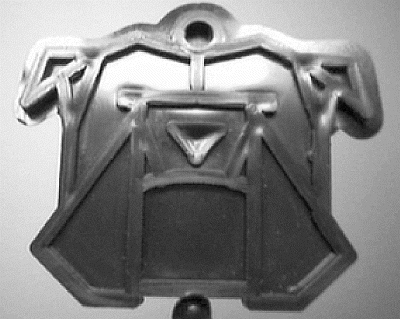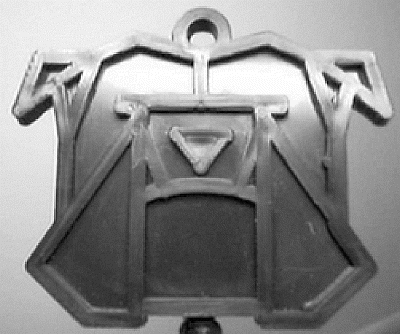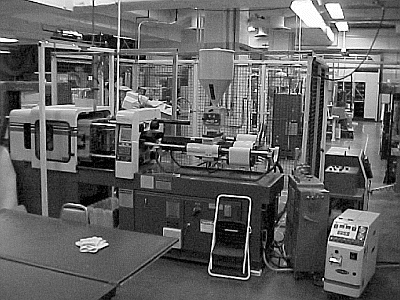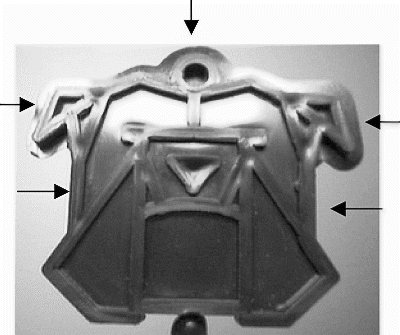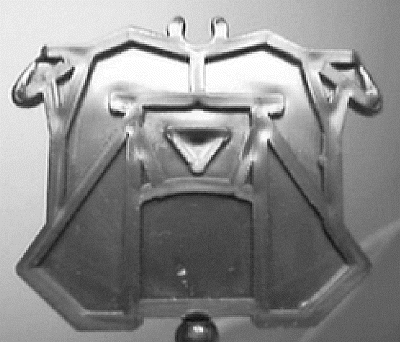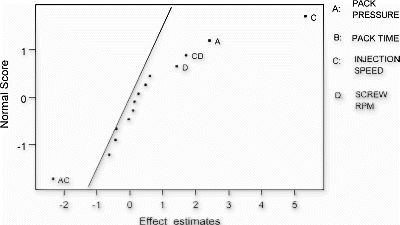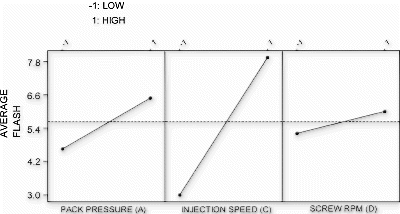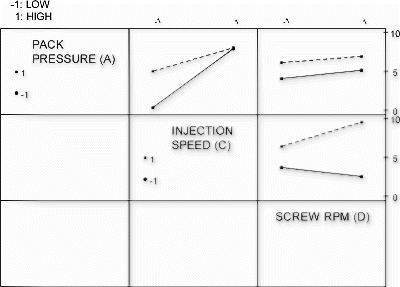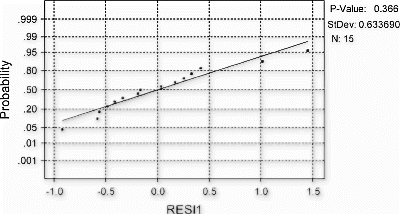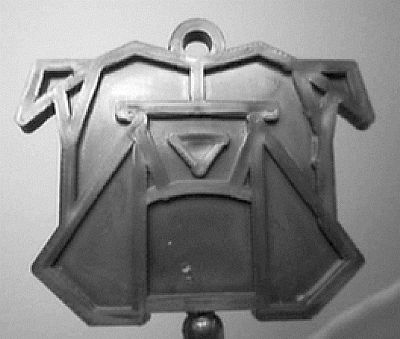Abstract
This paper was originated by a problem that occurred in an injection-molding project. The mold design team reported that the machine produced excessive flash on the molded part, the Bulldog, of Kettering University's mascot. The investigation of the manufacturing process problem required the understanding of many factors that influenced excessive flashing. After discussion and input from the team, a simple four-factor full-factorial design with duplicate measurements was used for the experiment. The analysis revealed that factors A (pack pressure), C (injection speed), and D (screw RPM) and also the interactions AC and CD were significant. The settings for A, C, and D were obtained. The confirmation runs showed that the setting of A at low level (150 psi), C at low level (0.5 in./sec), and D at high level (200 rpm) produced Bulldogs with zero flash.
Introduction
Kettering University is a school for engineering and managerial studies located in Flint, Michigan. The Manufacturing Engineering Program has a polymer-processing and injection-molding lab, which provides the students with hands-on manufacturing experience and problem-solving skills. As part of the integrated curriculum reform, a project to design and manufacture the university's mascot, the Bulldog, was launched. A project team in the polymer-processing laboratory designed the mold for the bulldog. During the manufacturing phase of the bulldog, the team encountered a few problems. One problem was that the process of injection molding the part created excessive flash. Figures , show bulldogs with and without flash, respectively. To solve this quality defect problem, it was necessary to investigate the injection-molding process thoroughly, using engineering knowledge and skills learned from polymer-processing and statistical tools such as Design of Experiments. This paper will discuss the use of Design of Experiment to solve the bulldog's excessive flash problem.
Injection-molding Process And The Machine
Injection molding (Citation2) is the process whereby a quantity of plastic material in solid or granular form is heated and softened in one part of the machine and then forced under pressure into a mold where the material is cooled and hardened so that plastic material retains the shape imparted to it.
The three basic sections in an injection-molding machine (Citation2) are:
| 1. | Injection unit: melts the polymer resin and injects the polymer melt into the mold. | ||||
| 2. | Mold: a hollow form or cavity into which molten plastic material is forced to give the shape of the required component. | ||||
| 3. | Clamping system: holds the mold together, opens and closes it automatically, and ejects the finished part. | ||||
Figure shows the screw-type injection-molding machine used in the laboratory.
Application Of Design Of Experiments
Experimental design is an important tool in the injection-molding industry for improving the performance of a manufacturing process. In this paper, the techniques were applied to deal with the quality problem of a product, i.e., excessive flash on a bulldog. The objectives of this study were to:
| 1. | Determine which factors influence the response variable, i.e., flash on the bulldog. | ||||
| 2. | Establish settings of the influential factors that would result in the minimum amount of flash on a bulldog. | ||||
| 1. | Melt temperature: Temperature has to be set in a range so that viscosity is not too low and the resin does not leak between the mold plates. | ||||
| 2. | Clamp pressure: Pressure has to be high enough so that the mold closes effectively against the forces developed from the injection process. | ||||
| 3. | Injection pressure: This pressure has to be lower than the clamp pressure so that the mold is not opened during the injection process. | ||||
| 4. | Mold construction: Good alignment of mold cavities and adequate venting reduces flashing. | ||||
Based on the discussion and input from the project team, it was decided that a 24 factorial design would be appropriate for the experiment. The four factors, pack pressure, pack time, injection speed, and screw RPM, are considered to affect the formation of flash. Their appropriate settings were identified.
The high and low levels for each factor are shown in Table .
Table 1. Factors with high and low levels
The Experiment And Data Collection
Sixteen randomized experimental runs were generated. The experiment was conducted by running each setting for 10 cycles to stabilize the machine and then four bulldogs were made consecutively.
Each molded part is measured for flash at the five locations as indicated in Fig. . The measurements are in millimeters, and the average of the recorded values for each part is considered as the flash.
From the experiment, there is one run with all factors at low levels that produce defective bulldogs (Fig. ). The defective part cannot be assigned a zero or negative value as it affects the average flash value. As a result, the only reasonable approach is to treat the run as a missing data.
Table shows the run order of the experiment, high and low settings of each factor for each run, and the average flash measurements on bulldogs.
Table 2. Design of experimental run and average flash
Data Analysis And Recommendation
Since this is an experiment with duplicate measurements, the response variable used for the analysis is the average of the flash measurements as suggested by Citation1. Citation3, a statistical software package, was used to analyze the data. Figure shows the normality plot of the effects. By examining the plot, we can conclude that the important effects from the analysis are the main effects of A (pack pressure), C (injection speed), and D (screw RPM) and the AC and CD interactions.
The main effects A, C, and D are plotted in Fig. , and the interaction effects AC and CD are plotted in Fig. . The AC interaction indicates that low pack pressure (A) and low injection speed (C) would produce low average flash. From CD interaction, we notice that screw RPM (D) has little effect on flash generation at low level of injection speed (C). Preliminary analysis of the three-factor (A, C, and D) full-factorial design showed that two-way interaction AD and three-way interaction ACD were not significant.
Table shows the estimated regression coefficients based on the significant effects and interactions.
Table 3. Estimated regression coefficients for average flash
For the reduced model using only the significant effects A, C, D, AC, and CD, the estimated regression equation with R2=96.4% is given by
Table illustrates the ANOVA output following the removal of the nonsignificant terms. A lack of fit test indicates that the estimated regression model is adequate.
Table 4. Analysis of variance (ANOVA) table
The independence and constant variance assumptions of residuals were checked, and results were satisfactory. The normality plot of the residuals in Fig. verifies the normality assumption and supports our conclusion and analysis.
Based on our analysis, the production run should set the pack pressure at low level (150 psi), pack time at high level (5 sec), injection speed at low level (0.5 in./sec), and screw RPM at either low (100 rpm) or high level (200 rpm).
Confirmation Runs With The Recommended Settings
We conducted the confirmation runs for the recommended settings. Ten bulldogs were produced consecutively for each setting, and the flash was measured. The results were tabulated as shown in Table .
Table 5. Flashes produced for confirmation runs
Figures , show the bulldogs produced by settings 1 and 2, respectively.
Conclusion
In this paper, the analysis and diagnosis of the injection process problem in producing the defective product is accomplished by using Design of Experiments. A simple two-level factorial experiment was used to identify the influential factors that impact the process. The confirmation runs showed that excessive flash could be reduced to zero under properly controlled conditions. It is our belief that the combination of statistical tool and injection process knowledge can provide engineers a solid problem-solving foundation.
Acknowledgments
References
- in press .
- Montgomery , D.C. 1997 . Design and Analysis of Experiments , 5th ed. pp. 265 – 269 . New York : John Wiley & Sons .
- Philip , M. 1996 . “ Injection Molding ” . In Tool and Manufacturing Engineers Handbook , 4th ed. Vol. 8 , 6-1 – 6-2 . Dearborn, MI : Society of Manufacturing Engineering .
